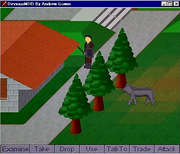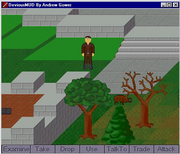
Some of the few available screenshots from DeviousMUD.
DeviousMUD was a game that eventually became RuneScape Classic. It was created in 1998 by Andrew Gower.
History[]
DeviousMUD started out in 1998 as a game written solely by Andrew Gower in his home in Cambridge. "MUD" stands for multi-user dungeon. The game had isometric graphics.
A new version of DeviousMUD was released in 1999. Although it was completely rewritten, it kept the same name and remained similar to the original. It was released as a public beta for 1 week. Because of the limited release time, there are only a few screenshots in existence.

Another screenshot of DeviousMUD.
In October 1999, he started another rewrite, this time with his brothers Paul and Ian Gower. A number of changes were made, and the game was renamed to RuneScape, the version that is now referred to as RuneScape Classic.
Most of the places on the maps are currently on the real RuneScape map.
The First period[]
DeviousMud had isometric graphics and was never shown to the public. Only Andrew played this version. According to some sources, this game was written at the University of Cambridge.
The Second period[]
A newer version came out in 1999. However, this game was much better, but the name of the game was the same: DeviousMUD. The beta version was only released to the public for one week. Because this was such a short period, people did not take that many screenshots of it. However, it was a downloadable client.

The original world map for DeviousMUD.[1]
Game Mechanics[]
The information below is original site material (verbatim), but has since been removed[2]:
- The whole game is written in Java, which means no waiting for downloads or installing software. You'll be able to just go straight to the webpage and play!
- Multiplayer! - You will be automatically connected to the main server, and your character will appear in the multiplayer game world, and vanish when you leave.
- Superfast isometric style engine, very optimised code with smooth 8 way scrolling.
- Detailed 3-dimensional map with hills, valleys, multi-levelled buildings, underground cellars and lots of variety.
- Efficient network code using lots of nice tricks to increase performance, and decrease lag. Only requires a bandwidth of 0.3k/sec for very smooth gameplay!
- Your game is automatically saved when you quit, so when you come back you can just resume where you left off, even if you are playing from a completely different computer!
- Minimal load times. I'm keeping the program as small as possible without decreasing the quality. Additional graphics and information are loaded as needed for plenty of variety.
- Graphical adventure style quest system gives you lots to do, and should ensure quests are easy to find and understand.
- A whole range of skills your character can try, which will improve with practice.
- Lots of different monsters and characters with different attributes.
- A variety of objects and weapons. What you are holding changes your appearance!
- Communicate with other players! Organise parties of characters with a range of skills to explore the dangerous areas. etc...
- Trading system, used to buy objects in shops, or trade with other characters.
- I'm writing the game in a very expandable way using script files, so once I've got the basic work finished I'll be able to make it huge very quickly.
- Multiple choice conversation system for talking to computer controlled characters
- Loads and loads of other cool features, far too many to list!
Updates in the second period[]
Andrew Gower listed updates that he had made [3]:
- 12 March|12 March, Fixed some nasty duplicate login bugs, and various other bugs...
- 13 March|13 March, Started work on a player-2-npc multiple choice style conversation system.
- 14 March|14 March, Continue work on conversation system
- 15 March|15 March, Finished player-2-npc conversation system.
- 15 March|15 March, Important background scenary can now be named, and manipulated by the player!
- 16 March|16 March, Improved player-2-player conversation system.
- 16 March|16 March, Started writing quest compiler. This is amazing, it runs everything from magic, to professions, to quests!
- 17 March|17 March, Finished quest compiler! Although it doesn't support many commands yet.
- 18 March|18 March, Spent ages debugging game - Fixed 11 (fairly minor) bugs!
- 18 March|18 March, Wrote auto bug reporting system for client
- 19 March|19 March, Started updating player 'Identikit' system.
- 22 March|22 March, Finish identikit system. You can now choose your player's appearance! System can also be used for human NPCs
- 25 March|25 March, Finished designing a wood/forest to the left of the starting zone
- 28 March|28 March, Fixed some more bugs. I've not got as much done as I would have liked but I'm putting it online anyway...
To do after the second period[]
- Level/skill advancment.
- Player variables, so extra information about what the player has done can be saved
- Projectiles system
- Player-2-player trading
- Fix it so certain NPCs can cross zone boundaries.
- A really big map with lots of quests!
- Health regeneration
- Add lots and lots more features to quest system
The server[]
DeviousMUD's server could hold more people than the current servers in RuneScape. 2500 players could play on this server, but only 97 people played.
The bandwidth you needed for playing DeviousMUD smoothly was 0.3k/sec.[4]
The skills[]

Other of the few available screenshots from DeviousMUD.
There is very little information about the skills in DeviousMUD. In the beginning of DeviousMUD, players could not get levels up, but after some days this changed[source needed]. The maximum combat level was 52[source needed]. There was also a kind of Summoning - players could let a dog behind them and let it fight, but it was very weak and died very often[source needed].
The skills known to be there, but not known to be implemented were:
- Attack (you started out with 10)
- Defense (you started out with 10)
- Strength (you started out with 10)
- Hits (you started out with 10)
- Ranged
- Thieving
- Hiding
- Prayers-Good
- Prayers-Evil
- Sorcery-Defence
- Sorcery-Offence
- Cooking
- Fishing
- Woodcutting
- Firemaking
- Fletching
- Smithing
- Mining
The equipment stats[]
There were equipment stats but there is no information on how they would benefit or affect the player.[5]
- Weight
- Armour Class
- Weapon Class
- Weapon Power
- Magic Class
- Prayers Class
- Hiding Class
Talk[]
On your screen were the options: Examine, Take, Drop, Use, Trade, Attack, and "TalkTo". You could talk with that option, just like public chat now.
Shops[]
Two shops and only about 10 objects existed[source needed].
Quests[]
There was only one, not fully made quest: Sheep Shearer[source needed].
Players who've played this game[]
- Andrew Gower (Concept, programming, design)
- Ian Gower(Graphics and 3d-modeling )
- Paul Gower(Maps, quests, design)
- Rab (Thanked Rab for Romeo and Juliet: Rob Law, Quest design)
- Lightning
- Gugge
- Merlin
- Echaze
- Anaksunamon
- Swtkittn
- Hurtbullen
- Flumbullen
- Tex 1
- Luna Fairy
- Villandra
- Javulen
- Munday
- Zaptone Z
- Ironbear
See also[]
External links[]
- http://sleepy.fitz.cam.ac.uk/mud/ The original website, now unavailable